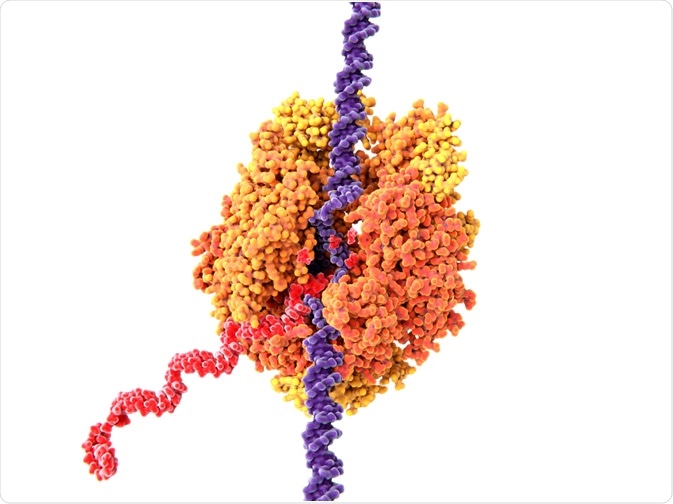The past several years have seen an increase in the interest of long non-coding RNAs (lncRNAs).

Image Credit: Juan Gaertner/Shutterstock.com
On an almost weekly basis, new lncRNAs are identified to be upregulated or downregulated in various pathologies. The advancement in technologies of high-throughput, sensitive genomic technologies such as microarrays and next-generation sequencing has allowed an unprecedented ability to detect novel transcripts.
It was previously identified that only a small proportion of the mammalian genome is transcribed into mRNAs, whilst the remainder of the genome was transcribed into ‘dark matter’, which has now been identified as non-coding RNA that is not encoded into proteins.
Among these non-coded RNAs are lncRNAs, which represent the most prevalent and functionally diverse class. Whilst there is no definition focusing on its biological role, it is typically agreed as having more than 200 nucleotides in length; whilst the remainder is considered ‘small’ RNAs.
lncRNAs have been observed in a large diversity of species including animals, plants, yeast, prokaryotes, and even viruses.
However, they are poorly conserved among different species relative to well-studied RNAs (mRNAs and miRNAs) invoking a degree of uncertainty about whether lncRNA is functional at all due to poor inter-species conservation.
Furthermore, lncRNA is typically expressed in low levels alluding to ‘transcriptional noise’.
In spite of this, they have been demonstrated to have a significant role in important biological processes such as pluripotency, cell cycle, apoptosis in addition to regulating cancer progression and various human diseases.
Subtypes of lncRNA
lncRNAs are composed of non-protein coding transcripts >200 nucleotides in length. It is the group in which a majority of non-coding RNAs belong.
Many of the lncRNAs are subject to splicing, polyadenylation, and other post-transcriptional modifications. They are broadly classified according to the proximity to protein-coding genes.
There is a subgroup of lncRNAs, named large intergenic RNAs (lincRNAs), which are typically a marker of trimethylation of K4 on histone H3 (H3K4me3) at their promoter and trimethylation of K36 on histone H3 (H36me3) along the transcribed region.
They have also been identified to have a role in epigenetic gene silencing, such as the role of Xist (X-inactive specific transcript) and tumor development by promoting the expression of genes involved in metastasis and angiogenesis.
lncRNA in cancer
Due to their role in embryogenesis and development, the role of lncRNAs implicated in human diseases is an ever-growing subject.
Numerous studies have implicated lncRNAs in the pathophysiology of various cancers. An example of which is HOTAIR, a lncRNA encoded within the HOX cluster has been identified in promoting metastasis in breast, colorectal, pancreatic and ovarian cancers.
HOTAIR lncRNA is overexpressed in these metastatic cancers, meanwhile, this also alters the occupancy of PRC2 across the genome subsequently rearranging the landing of H3K27me3 in cells. Notably, HOTAIR acts in trans to alter the specificity of PRC2, therefore, repressing the anti-metastatic genes.
Furthermore, the pro-myogenic role of H19 is consistent with previous studies in which the inactivation of H19 was linked to the development of rhabdomyosarcoma. Rhabdomyosarcoma is a pediatric tumor arising from defective skeletal muscle differentiation.
As miR-675-3p and -5p can promote myogenic differentiation, these two miRNAs may offer a therapeutic target for rhabdomyosarcoma. H19 activation has also been further linked to the development of Wilms’ tumor.
In this case, it might be worth further investigating these two miRNAs and their tumor suppressor activity
lncRNA in muscular dystrophies
Aside from cancers lncRNAs have been attributed to other diseases, particularly where defects in differentiation are observed.
Within some subtypes of muscular dystrophy, a few lncRNAs are showing an altered expression pattern- namely within Duchenne muscular dystrophy (DMD) and facioscapulohumeral muscular dystrophy (FSHD).
There is a reduced expression of linc-MD1 in myoblasts isolated from DMD patients. The abnormal kinetics of differentiation in myoblasts isolated from DMD patients were partially corrected by the introduction of exogenous linc-MD1; this, therefore, suggests a crucial role in DMD.
Lastly, the lncRNA encoded by the D4Z4- binding element (DBE-T) has been seen to be selectively expressed in FSHD patient samples. DBE-T increases H3K36me2 through the recruitment of the MLL1 complex resulting in excessive transcriptional activation of the FSHMD1A locus in patients with FSHD.
The translational potential of lncRNA
lncRNAs when isolated from tumor cells or the circulatory system could provide a readily available, inexpensive and stable blood-borne diagnostic assay to readily detect both cancer and its subtype.
Work by Yang et. al. analyzed eight lncRNAs in 240 patients with hepatocellular carcinoma and reportedly found the lncRNA ‘highly upregulated in liver cancer’ HULC was significantly associated with vascular invasion and was further positively associated with overall and disease-free survival time.
lncRNAs are an attractive therapeutic target within cancers. lncRNAs could also function as a miRNA or mRNA sponges, therefore, inhibiting the pro-tumorigenic signaling pathways so that synthetically engineered lncRNAs may be used as replacement therapy to inhibit the growth of tumor cells.
Similarly, Dextran nanoparticles can deliver chemotherapy to the nucleus of cells, which may be used to attach cytotoxic agents to lncRNAs. This offers a more personalized approach to treatment and can also reduce widespread side effects where healthy tissue may also be damaged.
Sources
- Bijan K Dey, Adam C Mueller & Anindya Dutta (2014) Long non-coding RNAs as emerging regulators of differentiation, development, and disease, Transcription, 5:4, DOI: 10.4161/21541272.2014.944014
- Malek E, Jagannathan S, Driscoll JJ. Correlation of long non-coding RNA expression with metastasis, drug resistance and clinical outcome in cancer. Oncotarget. 2014;5:8027-38
- Cesana M, Cacchiarelli D, Legnini I, Santini T, Sthandier O, Chinappi M, Tramontano A, Bozzoni I. A long noncoding RNA controls muscle differentiation by functioning as a competing endogenous RNA. Cell 2011; 147:358-69; PMID:22000014; http://dx.doi.org/10.1016/j.cell.2011.09.028
- Yang Z, Lu Y, Xu Q, Tang B, Park CK, Chen X. HULC and H19 Played Different Roles in Overall and Disease-Free Survival from Hepatocellular Carcinoma after Curative Hepatectomy: A Preliminary Analysis from Gene Expression Omnibus. Dis Markers. 2015;2015:191029
Further Reading
Last Updated: Mar 13, 2020